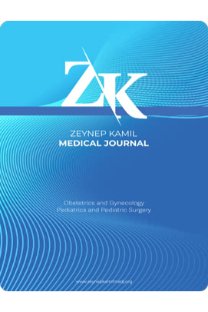Gebeliğin Kolestatik Hastalığında Maternal ve Perinatal Sonuçlar
Maternal and Perinatal Outcomes In Cases of Intrahepatic Cholestasis of Pregnancy
___
- 1. Shornick, JK. Dermatoses of pregnancy. Semin Cutan Med Surg 1998; 17:172.
- 2. Pata, O, Vardareli, E, Ozcan, A, et al. Intrahepatic cholestasis of pregnancy: correlation of preterm delivery with bile acids. Turk J Gastroenterol; 22:602.
- 3. Bacq, Y, Sapey, T, Brechot, MC, et al. Intrahepatic cholestasis of pregnancy: a French prospective study. Hepatology 1997; 26:358.
- 4. Rioseco, AJ, Ivankovic, MB, Manzur, A, et al. Intrahepatic cholestasis of pregnancy: a retrospective case-control study of perinatal outcome. Am J Obstet Gynecol 1994; 170:890.
- 5. Lee, RH, Incerpi, MH, Miller, DA, et al. Sudden fetal death in intrahepatic cholestasis of pregnancy. Obstet Gynecol 2009; 113:528.
- 6. Lee, RH, Goodwin, TM, Greenspoon, J, Incerpi, M. The prevalence of intrahepatic cholestasis of pregnancy in a primarily Latina Los Angeles population. J Perinatol 2006; 26:527.
- 7. Arrese, M, Macias, RI, Briz, O, et al. Molecular pathogenesis of intrahepatic cholestasis of pregnancy. Expert Rev Mol Med 2008; 10:e9.
- 8. Jacquemin, E, De Vree, JM, Cresteil, D, et al. The wide spectrum of multidrug resistance 3 deficiency: from neonatal cholestasis to cirrhosis of adulthood. Gastroenterology 2001; 120:1448.
- 9. Gonzalez, MC, Reyes, H, Arrese, M, et al. Intrahepatic cholestasis of pregnancy in twin pregnancies. J Hepatol 1989; 9:84.
- 10. Reyes, H, Simon, FR. Intrahepatic cholestasis of pregnancy: an estrogen-related disease. Semin Liver Dis 1993; 13:289.
- 11. Heikkinen, J, Maentausta, O, Ylostalo, P, Janne, O. Changes in serum bile acid concentrations during normal pregnancy, in patients with intrahepatic cholestasis of pregnancy and in pregnant women with itching. Br J Obstet Gynaecol 1981; 88:240.
- 12. Brites, D, Rodrigues, CM, Oliveira, N, et al. Correction of maternal serum bile acid profile during ursodeoxycholic acid therapy in cholestasis of pregnancy. J Hepatol 1998; 28:91.
- 13. Ropponen, A, Sund, R, Riikonen, S, et al. Intrahepatic cholestasis of pregnancy as an indicator of liver and biliary diseases: a population-based study. Hepatology 2006; 43:723.
- 14. Hirvioja, ML, Kivinen, S. Inheritance of intrahepatic cholestasis of pregnancy in one kindred. Clin Genet 1993; 43:315.
- 15. Serrano, MA, Brites, D, Larena, MG, et al. Beneficial effect of ursodeoxycholic acid on alterations induced by cholestasis of pregnancy in bile acid transport across the human placenta. J Hepatol 1998; 28:829.
- 16. Sepulveda, WH, Gonzalez, C, Cruz, MA, Rudolph, MI. Vasoconstrictive effect of bile acids on isolated human placental chorionic veins. Eur J Obstet Gynecol Reprod Biol 1991; 42:211.
- 17. Williamson, C, Hems, LM, Goulis, DG, et al. Clinical outcome in a series of cases of obstetric cholestasis identified via a patient support group. BJOG 2004; 111:676.
- 18. Saleh, MM, Abdo, KR. Consensus on the management of obstetric cholestasis: National UK survey. BJOG 2007; 114:99.
- ISSN: 1300-7971
- Yayın Aralığı: 4
- Başlangıç: 1969
- Yayıncı: Ali Cangül
Osteoklast Benzeri Dev Hücreler İçeren Leiomyosarkom
Hülya YAVUZ, Suna CESUR, Ecmel KAYGUSUZ, Ateş KARATEKE
Overin Granüloza Hücreli Tümörlerinde Klinik Deneyimlerimiz
Ateş KARATEKE, Mehmet GÜZELGÜL, SELÇUK AYAS, Çetin ÇAM, Mehmet REŞİT ASOĞLU
Molar Gebeliklerde Ultrasonografi ile Klinik Ön Tanı Başarısı
Özgür Aydın TOSUN, Pınar BATU, Arzu ARINKAN, ABDULKADİR TURGUT, Çetin ÇAM, Ateş KARATEKE
Çocuklarda Görülen Tip 1 Duane Sendromunda Güçlendirilmiş Vertikal Rektus Kas Transpozisyonu
Serhat İMAMOĞLU, GÖKHAN PEKEL, Birsen GÖKYİĞİT, Evren PEKEL, Serpil AKAR, NİHAT SAYIN, Ahmet DEMİROK
Gebeliğin Kolestatik Hastalığında Maternal ve Perinatal Sonuçlar
Turhan ARAN, Mehmet Armağan OSMANAĞAOĞLU, RECEP ERİN, Hasan BOZKAYA
Hızlı Test ile İnfluenza A ve B Tanısının Klinik Bulgulara Göre Değerlendirilmesi
CEM PAKETÇI, Rabia GÖNÜL SEZER, Ahu PAKETÇİ, Züleyha Aysu SAY
Peser Kullanımı İle İlişkili Serviks Kanseri: Olgu Sunumu
